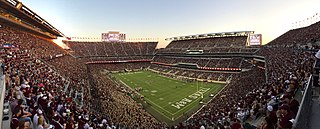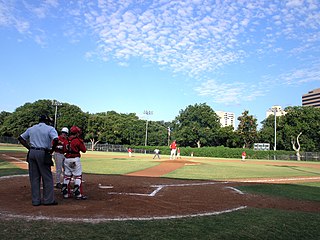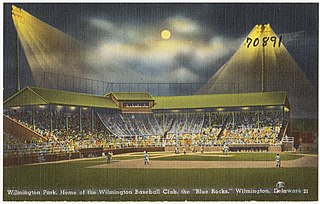Related Research Articles

Kyle Field is the American football stadium located on the campus of Texas A&M University in College Station, Texas, United States. It has been the home to the Texas A&M Aggies football team in rudimentary form since 1904, and as a permanent concrete stadium since 1927. The seating capacity of 102,733 in 2021 makes it the largest in the Southeastern Conference and the fourth-largest stadium in the NCAA, the fourth-largest stadium in the United States, and the sixth-largest non-racing stadium in the world and the largest in Texas.

Olsen Field at Blue Bell Park is a baseball stadium in College Station, Texas, that is home to the Texas A&M baseball program. The stadium was dedicated on March 21, 1978, and is named in honor of C. E. "Pat" Olsen, a 1923 graduate of Texas A&M University and a former baseball player in the New York Yankees farm system. Olsen Field has served as an NCAA regional site five times and had its 1999 regional attendance ranked second with 53,287. The first NCAA Regional Tournament held at Olsen Field was in 1989.

The G. Rollie White Coliseum was an on-campus arena at Texas A&M University in College Station, Texas, in the United States. Often referred to as the "Jollie Rollie" or "The Holler House on the Brazos", the arena was the home of Texas A&M's Aggie volleyball team, which played there since its inception in 1975 until 2009. Before the building of Reed Arena in 1998, G. Rollie White was also the home to the men's and women's basketball teams. Demolition of the Coliseum in August, 2013 made way for the redevelopment of Kyle Field.

The Texas A&M Aggies are the students, graduates, and sports teams of Texas A&M University. The nickname "Aggie" was once common at land-grant or "ag" (agriculture) schools in many states. The teams are also simply referred to as "A&M" or "Texas Aggies," and the official school colors are maroon and white. The mascot is a rough collie named Reveille.

Reverchon Park is a public park in the Oak Lawn area of Dallas, Texas. It was named for the French botanist Julien Reverchon.

The Texas A&M Aggies football program represents Texas A&M University in the sport of American football. The Aggies compete in the Football Bowl Subdivision (FBS) of the National Collegiate Athletic Association (NCAA) and the Western Division of the Southeastern Conference (SEC). Texas A&M football claims three national titles and 18 conference titles. The team plays all home games at Kyle Field, a 102,733-person capacity outdoor stadium on the university campus.

Darryl & Lori Schroeder Park is a baseball park in Houston, Texas. It is the home field of the Houston Cougars baseball team. Several iterations of the ballpark have existed. The current stadium holds 5,000 people, and opened for baseball in 1995. With a 1,500 square foot Daktronics video board, Schroeder Park features the second-largest scoreboard in college baseball. Since its opening, Schroeder Park has hosted several notable college baseball events. In February 2016, the University of Houston announced that, as a response to a large donation to the baseball program, Cougar Field would be renamed Darryl & Lori Schroeder Park.
Clarence William Byrne Jr. is an American retired college athletics administrator. He was the athletic director at the University of Oregon from 1984 to 1992, at the University of Nebraska–Lincoln from 1992 to 2002, and at Texas A&M University from January 2003 to May 8, 2012, when he retired. He was a Special Adviser to Texas A&M University President R. Bowen Loftin until August 31, 2012. Upon leaving the athletic department, he held the title of athletic director emeritus at Texas A&M.

Clark Field was a baseball park in Austin, Texas, used primarily by the University of Texas Longhorns. The field was used from 1928 until 1974. It is considered one of the most novel ballparks ever conceived thanks to its location. There was a limestone cliff in the outfield that created havoc for outfielders and made baseball games exciting. It was replaced by UFCU Disch-Falk Field in 1975.

The Arkansas–Texas A&M football rivalry is an American college football rivalry between the Arkansas Razorbacks and Texas A&M Aggies, which started in 1903. Between 1992 and 2008, the schools did not play each other when Arkansas left the Southwest Conference to join the Southeastern Conference. The rivalry was renewed as a neutral-site out-of-conference contest in 2009; in 2012 it once again became a conference rivalry when Texas A&M also joined the Southeastern Conference. Arkansas leads the series 42–35–3.

The Texas A&M Aggie baseball team represents Texas A&M University in NCAA Division I college baseball. The Aggies have competed in the Southeastern Conference since 2013. The Aggies play home games at Olsen Field at Blue Bell Park. The team is led by head coach Jim Schlossnagle.
The 1918 Texas A&M Aggies football team represented the Agricultural and Mechanical College of Texas as a member of the Southwest Conference (SWC) during the 1918 college football season. Led by first-year head coach D. V. Graves, the Aggies compiled an overall record of 6–1, with a mark of 1–1 in conference play. Texas A&M played home games at Kyle Field in College Station, Texas. Graves coached the Aggies for a year while Dana X. Bible served in the war.
Armstrong Field was a baseball park located in Dallas, Texas, on the campus of Southern Methodist University located where Westcott Field now stands. It first hosted SMU football from 1915 through 1925. It was the home of the SMU baseball team (1919–1980) for many years though at least the final four seasons were played off campus. The Mustangs, Southwest Conference participants, were a team of futility during their time at Armstrong Field, scarcely in competition to win the conference. Armstrong Field did have the advantage of being located next to an outdoor school swimming pool. Legend has it that collegians would sit in the two rows at the top of the stands to see the women at the pool instead of watching the ballgame. Some were hit with foul balls due to their concentration on the women at the pool. The pool helped augment attendance by 40%. Armstrong Field was closed after the 1976 season, but before the last game the players stole home plate and concealed it in the storage area of Ownby Stadium. The plate was signed by the players and ended up in the SMU sports information division. The final four years (1977–1980) of SMU Mustangs baseball were played at Reverchon Park before the baseball program was phased out.

Wilmington Park was a ballpark in Wilmington, Delaware that was located at the corner of 30th Street and Governor Printz Boulevard. It was home to the University of Delaware football team from 1940 to 1952 and the Wilmington Blue Rocks of the Class B Interstate League from 1940 to 1952. The Blue Rocks were an affiliate of the Philadelphia Athletics from 1940 to 1943 and the Philadelphia Phillies from 1944 to 1952.
Edible Field is a ballpark located in Bryan, Texas, and home to the TCL Brazos Valley Bombers and the USL2 Twin City Toucans soccer team. Renamed by a corporate sponsorship with Edible Arrangements in 2021, it was long known as Travis Field during its use by several minor-league baseball teams and Texas A&M Aggies baseball for several decades.

The 2016 Texas A&M Aggies football team represented Texas A&M University in the 2016 NCAA Division I FBS football season. The Aggies played their home games at Kyle Field in College Station, Texas and competed in the Western Division of the Southeastern Conference (SEC). They were led by fifth-year head coach Kevin Sumlin. They finished the season 8–5, 4–4 in SEC play to finish in fourth place in the Western Division. They were invited to the Texas Bowl where they lost to Kansas State.
The 1979 Texas A&M Aggies football team represented Texas A&M University in the 1979 NCAA Division I-A football season as a member of the Southwest Conference (SWC). The Aggies were led by head coach Tom Wilson in his second season and finished with a record of six wins and five losses.

The 2017 Texas A&M Aggies football team represented Texas A&M University in the 2017 NCAA Division I FBS football season. The Aggies played their home games at Kyle Field in College Station, Texas and competed in the Western Division of the Southeastern Conference (SEC). They were led by sixth-year head coach Kevin Sumlin. They finished the season 7–6, 4–4 in SEC play to finish in a tie for fourth place in the Western Division. They were invited to the Belk Bowl where they lost to Wake Forest. This season was the first time since 2009 that Texas A&M was not ranked in the AP Poll during the regular season.

The 2022 Texas A&M Aggies football team represented Texas A&M University in the 2022 NCAA Division I FBS football season. The Aggies played their home games at Kyle Field in College Station, Texas, and competed in the Western Division of the Southeastern Conference (SEC). They were led by fifth-year head coach Jimbo Fisher.

The 2023 Texas A&M Aggies football team represented Texas A&M University in the 2023 NCAA Division I FBS football season. The Aggies played their home games at Kyle Field in College Station, Texas, and competed in the Western Division of the Southeastern Conference (SEC). They were led by Jimbo Fisher in his sixth year as the team's head coach before his firing on November 12, 2023. Defensive line coach and co-defensive coordinator Elijah Robinson served as the team's interim head coach for the final 2 games of the season.
References
- ↑ "Brazos County Historical Timeline 1920-1939". www.brazosgenealogy.org. Archived from the original on 2005-01-09.